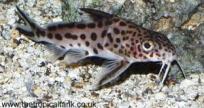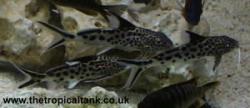

Above left photo taken at Wharf Aquatics
Photos © Sean Evans
|
| Common name: | Cuckoo Synodontis, Cuckoo catfish, Many-Spotted catfish |
| Scientific name: | Synodontis multipunctatus |
| Synonyms: | (none) |
| Size: | Up to 6" (15cm), females larger. |
| Origin: | Lake Tanganyika, East Africa. |
| Tank setup: | Large tank, with lots of rocky decor to provide caves. Well-soaked bogwood can be added. |
| Compatibility: | Usually kept with cichlids of Malawi and Tanganyika. Slightly territorial towards
its own species, but much less so than many Synodontis species. |
| Temperature: | 22-26oC (72-79oF) |
| Water chemistry: | Hard and alkaline, pH 7.5-8.5, preferable. |
| Feeding: | An insectivore, so live or frozen foods may be prefered, but will accept flake and tablet foods. Snail eater. |
| Sexing: | Males tend to be smaller and may have longer pectoral spines. Like other Synodontis, it may also
be possible to see a short papillae close to the males vent. |
| Breeding: | The common name of 'Cuckoo' derives from this catfishes habit of swimming between
spawning cichlids, eating their eggs and depositing their own. The eggs are then picked up by the mouthbrooding
female cichlid and the resulting fry raised with her own fry. |
| Comments: |
A very attractively patterned catfish which makes an ideal and interesting addition to a Rift Lake setup
of Malawi or Tanganyika cichlids. They are often more active in the daytime than many other Synodontis, especially if a small group is kept.
|





